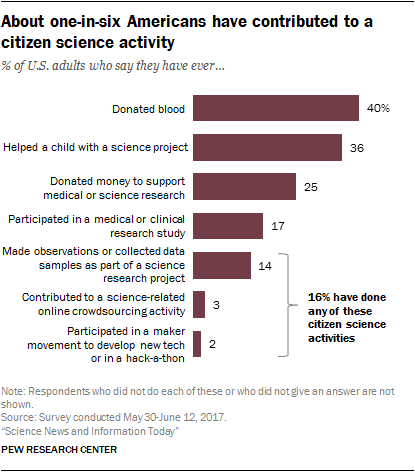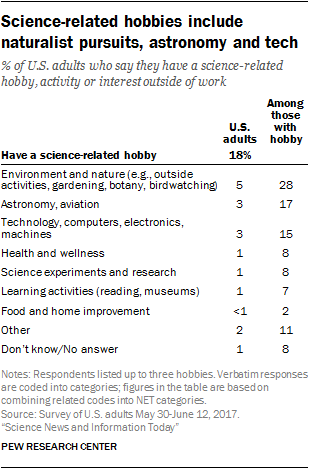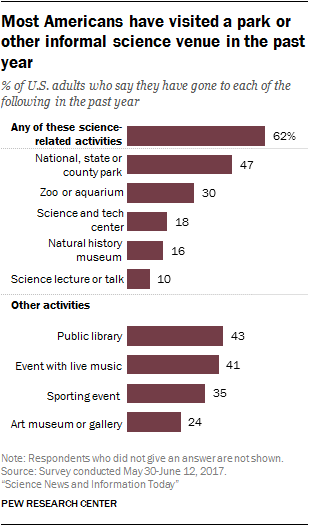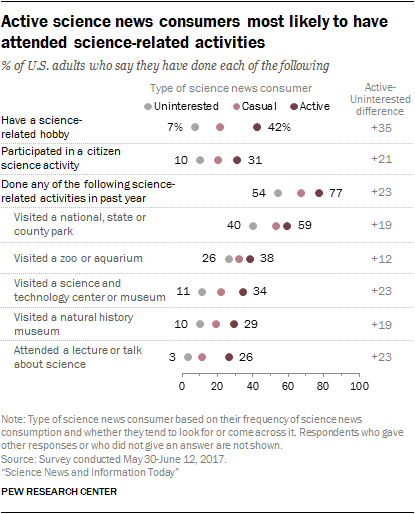Participation in science-related activities serves as another source for informing the public. The past two decades have seen a resurgence in direct public engagement with science – especially through citizen science and crowdsourcing activities – as a way to learn about the process of scientific inquiry and foster a deeper dialogue around the relationships between science and society.16
Citizen science encompasses a diverse range of activities, such as birdwatching, weather monitoring, processing and analyzing astronomical data, and do-it-yourself science projects.

Overall, 16% of U.S. adults report having done at least one of the following citizen science activities: made observations or collected data samples as part of a science research project, contributed to a science-related online crowdsourcing activity, or participated in a maker movement or hack-a-thon.
A similar share (17%) of adults have participated in a medical or clinical research study. One of the most common ways that Americans directly engage with medical care and research is by donating blood (40% of Americans say they have done this at least once). A quarter of Americans (25%) have donated money to support medical or science research.
Some 45% of parents with minor-age children (and 36% of all adults) have helped a child with a science project for school or an outside activity.
18% of Americans engage with science through hobbies, interests and activities at home

About one-in-five Americans (18%) report they have what they consider to be a “science-related hobby, interest or activity they do outside of work.”
Among the most popular:
- 5% of Americans pursue hobbies related to the environment and nature, such as outdoor and naturalist activities, gardening, and botany.
- 3% of Americans have interests in aviation or rocket building, astronomy, and star-gazing.
- 3% of Americans have technology hobbies, such as computer programming and robotics.
Most Americans have been to a park, museum or informal science event in the past year

There are a number of other ways people encounter science information in their everyday lives and, potentially, learn about science through informal environments.17 Visits to parks and museums are foremost among them.
Altogether, 62% of U.S. adults have encountered science through one of these informal institutions or events in the past year: a national, state or county park (47%); a zoo or aquarium (30%); a science and technology center or museum (18%); a natural history museum (16%); or a science lecture (10%).
Participation in these science-related activities is common among parents with children under age 18 (69%) as well as those without minor-age children (59%).
By comparison, about four-in-ten Americans have been to a public library (43%) or an event with live music in the past year (41%). Fewer have been to a sporting event (35%) or visited an art museum or art gallery in the past year (24%).18
Active science news consumers, the highly educated and more affluent are particularly likely to have a science hobby, participate in citizen science and other science-related activities

The 17% of Americans who are active science news consumers – saying they typically seek out science news and consume it at least a few times each week – are particularly likely to have participated in science-related activities. They are far more likely than uninterested news consumers to say they have a science related hobby (42% vs. 7%), to have participated in a citizen science activity (31% vs. 10%), or to have been to any of five informal science venues in the past year, such as a park or museum (77% vs. 54%).
Adults with more education and higher incomes levels are also more likely to have participated in any of these informal science activities and to have a science-related hobby. For details see Appendix A. This is in keeping with a number of past studies showing a tendency for those with higher education and income levels to visit science-related museums or participate in other informal science learning activities.19
Visits to science-related museums are frequently associated with activities for children. A 69% majority of parents with children under age 18 have visited a park, museum or gone to a science lecture in the past year but so, too, have 59% of adults with no minor children.
Younger generations are more likely than their older counterparts to report having a science-related hobby (23% of those ages 18 to 29 vs. 12% of those ages 65 and older) and to have participated in a citizen science activity (23% of those ages 18 to 29 vs. 11% of those ages 65 and older), but there are only modest differences by age in visiting an informal science institution. Further, older adults are more likely than younger adults to have been in a clinical or medical research study and to have given money to support medical or science research, even after controlling for income and other factors.




